Assessment of DHA in self-tanning creams applied in spray booths
6 User exposure
Exposure to DHA in the self-tanning products used in spray booths has been assessed on the basis of information in the literature, contacting manufacturers and suppliers, and from the results of measurements carried out by NERI.
6.1 Assessment of exposure
The assessment only covers exposure for the mucous membranes, eyes, and through inhalation. The assessment assumes that DHA is taken up 100 per cent via inhalation, the eyes, or mucous membranes.
The exposure scenarios are all realistic worst-case scenarios. NERI has carried out air measurements in the booths during use by customers, representing the impact on the customer. Moreover, measurements have been conducted in the room outside the booths while the customer is using the booths. This represents background concentrations in the room and the impact on salon staff/operators. The background concentrations are also part of the exposure for customers in the time they are in the salon, i.e. before and after treatment in the booths. Measurement data and figures were supplied by NERI and will be described in detail in the NERI report.
6.1.1 Exposure via inhalation
A general inhalation rate of 1.5 m³/hour has been assumed (adult man, low activity) for both customer and operator (39).
Measurements were taken in three types of spray booth in which DHA-containing self-tanning products were used. The three types of booth and the different techniques are described in more detail in 3.1. The following is a description of the exposures in the booths from using the different techniques, as well as background exposures outside the booths. Exposure assessments are all worst-case scenarios, so they do not take into account use of nose filters, for example (as shown in section 3.2.3).
Treatment lasts for 5-7 days. Two different worst-case scenarios have been described. In the first scenario the customer is treated once a week during the winter months, i.e. 1 October to 31 March inclusive (6 months = 26 weeks, i.e. a total of 26 times a year, corresponding to an average daily exposure of (26/365=) 0.07 times a day. The second worst-case scenario describes special cases for, e.g. TV presenters, actors and models, where exposure could be weekly throughout the year (12 months = 52 weeks, i.e. 52 times a year, corresponding to an average daily exposure of (52/365=) 0.14 times per day.
6.1.1.1 Exposure from manual turbine spray
NERI has carried out measurements during treatment of a customer with a manual turbine spray. The customer was sprayed for about 167 seconds and the air was collected from the customer's inhalation zone for 210 seconds. A period of 180 seconds was chosen to measure customer exposure, as this is the normal treatment time. 25 ml lotion was used. The booth was open and equipped with an extractor fan in the ceiling. For further technical details of the measurement procedure, please refer to the NERI report.
The results from the completed measurements are summarised in the table below.
Table 6.1. Concentration of DHA in droplets < 12 µm in the air around the mouth/nose during treatment with self-tanner using manual turbine spray
| Spraying time sec. |
Collection time. sec. | DHA in sample mg/m³ air |
Particle separation µm | |
| Measurement | 167 | 210 | 0.8 | 12 |
Three scenarios were established:
- Weekly exposure in the winter months
- Weekly exposure all year
- Exposure per treatment (acute exposure)
1. Weekly exposure in the winter months
The following calculation models were set up as worst-case scenarios at weekly exposure in the winter months with intake via inhalation:
| Weight of subject: | 60 kg |
| Inhalation rate: | 1.5 m³/hour |
| Number of treatments: | 0.07/day |
| Exposure time per treatment (180/60/60) | 0.05 hours |
| Daily exposure time (0.07 x 0.05): | 0.0035 hours |
Average daily exposure via airways is calculated as:
Daily exposure x inhalation rate x concentration of DHA in air =

2. Weekly exposure all year
The worst-case scenario below has been set up for particularly exposed groups such as TV presenters, actors and models who are exposed weekly throughout the year.
| Weight of subject: | 60 kg |
| Inhalation rate: | 1.5 m³/hour |
| Number of treatments: | 0.14/day |
| Exposure time per treatment (180/60/60) | 0.05 hours |
| Daily exposure (0.14 x 0.05): | 0.007 hours |
Average daily exposure via airways is calculated as:

3. Exposure per treatment
A person with an inhalation rate of 1.5 m³/hour, treated for 0.05 hours at a concentration of inhalable DHA in the air of 0.8 mg DHA/m³ air is exposed to (0.05 hours x 1.5 m³/hour x 0.8 mg/m³ air =) 0.06 mg DHA via inhalation per treatment.
6.1.1.2 Exposure using third-generation booth (closed booth)
During treatment in a third-generation booth, the customer is exposed to concentrated aerosol for 6 seconds and 60 ml lotion is used per treatment. The customer leaves the booth after spraying has stopped. Immediately after this, extraction fans start and the booth is rinsed so that excess aerosol is removed from the booth.
Table 6.2. Concentration of DHA in droplets < 12 µm in the air around the mouth/nose during treatment with self-tanning spray in third-generation booth
| Spraying time sec. |
Collection time sec. | DHA in sample mg/m³ air |
Particle separation µm | |
| Measurement Customer 1 | 6 | 14 | 238 | 12 |
| Measurement Customer 2 | 6 | 16 | 115 | 12 |
Three scenarios were established:
- Weekly exposure in the winter months
- Weekly exposure all year
- Exposure per treatment
1. Weekly exposure in the winter months
The following methods of calculation are set up as worst-case scenarios for uptake via inhalation and weekly exposure in the winter months.
| Weight of subject: | 60 kg |
| Inhalation rate: | 1.5 m³/hour |
| Number of treatments: | 0.07/day |
| Exposure time per treatment (6/60/60) | 0.0017 hours |
| Daily exposure (0.07 x 0.002): | 0.0001 hours |
Average daily exposure via airways is calculated as:
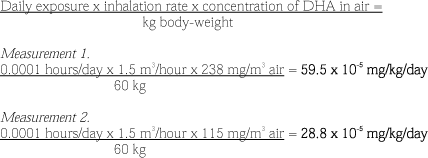
2. Weekly exposure all year
The worst-case scenario below has been set up for particularly exposed groups such as TV presenters, actors and models who are exposed weekly throughout the year.
| Weight of subject: | 60 kg |
| Inhalation rate: | 1.5 m³/hour |
| Number of treatments: | 0.14/day |
| Exposure time per treatment (6/60/60) | 0.0017 hours |
| Daily exposure (0.14 x 0.002): | 0.0003 hours |
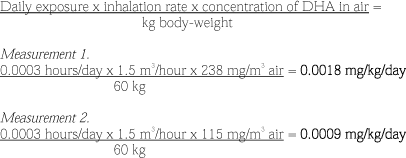
3. Exposure per treatment.
A person treated for 0.0017 hours at concentrations of DHA in air of 238 and 115 mg DHA/m³ air respectively is exposed as a worst-case to (0.0017 hours x 1.5 m³/hour x 238 or 115 mg/m³ air =) 0.61 or 0.29 mg DHA respectively via inhalation per treatment.
6.1.1.3 Exposure using fourth-generation booth (open booth)
Fourth-generation booths are open. The customer is sprayed twice for 2, 2½, or 3 seconds each time. For NERI's measurements the booth was set to spray for 2 x 3 seconds. A total of 15 ml lotion is used per treatment, and the spray mist is almost invisible immediately after treatment.
Table 6.3. Concentration of DHA in droplets < 12 µm in the air around the mouth/nose during treatment with a self-tanning spray in fourth-generation booth
| Spraying time sec. | Collection time sec. | DHA in sample mg/m³ air |
Particle separation µm | |
| Measurement Customer 1 | 6 | 35 | 3.3 | 12 |
| Measurement Customer 2 | 6 | 35 | 17 | 12 |
Three scenarios were established:
- Weekly exposure in the winter months
- Weekly exposure all year
- Exposure per treatment
1. Weekly exposure in the winter months
The following methods of calculation are set up as worst-case scenarios for uptake via inhalation and weekly exposure in the winter months:
| Weight of subject: | 60 kg |
| Inhalation rate: | 1.5 m³/hour |
| Number of treatments: | 0.07/day |
| Exposure time per treatment (6/60/60) | 0.002 hours |
| Daily exposure (0.07 x 0.002): | 0.0001 hours |
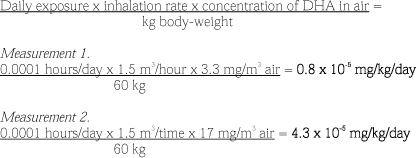
2. Weekly exposure all year
The worst-case scenario below has been set up for particularly exposed groups such as TV presenters, actors and models who are exposed weekly throughout the year.
| Weight of subject: | 60 kg |
| Inhalation rate: | 1.5 m³/hour |
| Number of treatments: | 0.14/day |
| Exposure time per treatment (6/60/60) | 0.002 hours |
| Daily exposure (0.14 x 0.002): | 0.0003 hours |
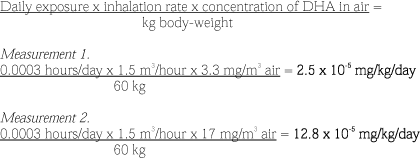
3. Exposure per treatment
A person treated for 0.002 hours at concentrations of DHA in air of 3.3 x 10-5 and 12.8 x 10-5 mg DHA/m³ air respectively is exposed as a worst-case to (0.002 hours x 1.5 m³/hour x 3.3 x 10-5 or 12.8 x 10-5 mg/m³ air =) 1 x 10-7 or 3.8 x 10-7 mg DHA respectively via inhalation per treatment.
6.1.1.4 Background exposure
Besides measuring the aerosol mist in the booth, measurements were also carried out of the background concentrations outside the booth, typically where the operator and waiting customers are.
Figure 6.1 shows how the concentration in air of self-tanning product falls with time in the room outside the booth. The x axis shows secs. after treatment.
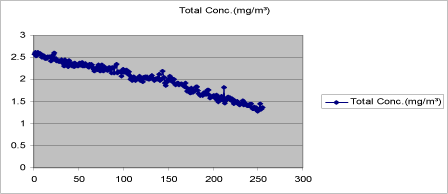
Extrapolating the curve to zero shows that it takes 9 minutes for the concentration of self-tanning product in the air to fall to zero. The results in table 6.4 have been used to calculate exposure to DHA.
Table 6.4. Concentration of DHA in droplets < 12 µm in the air around the mouth/nose beside a spray booth after three treatments with self-tanning spray
| Collection time minutes |
DHA in sample mg/m³ air |
Particle separation µm | |
| Manual and open booth | 30.5 | 0.29 | 12 |
| Closed booth | 30 | 0.5 | 12 |
The worst-case scenario used is an operator in the room outside the booths where three customers are treated per day for 227 working days per year. The values measured are a worst-case scenario as the three treatments are completed within a short period of time. These are usually spread over the working day. NERI's background measurements during treatment of customers were carried out for open booths and manual turbine spraying together, i.e. it is not possible to separate the air impacts from the two types of treatment.
The following method of calculation has been set up as a background scenario for an operator exposed via inhalation.
| Weight of subject: | 60 kg |
| Inhalation rate: | 1.5 m³/hour |
| Number of exposures (3 x 227/365 =) | 1.86/day |
| Exposure each time (9/60 =) | 0.15 hours |
| Daily exposure time (1.86 x 0.15 =) | 0.28 hours |

![]()
The worst-case scenario for the customer is that the customer waits/gets ready for five minutes while another customer is being treated. When the customer has finished treatment, she gets dressed for 10 minutes while a new customer is being treated. This means the customer is exposed for 15 minutes.
Weekly exposure, winter months:
| Weight of subject: | 60 kg |
| Inhalation rate: | 1.5 m³/hour |
| Number of treatments: | 0.07/day |
| Exposure time per treatment (15/60) | 0.25 hours |
| Daily exposure time (0.07 x 0.25 =): | 0.018 hours |
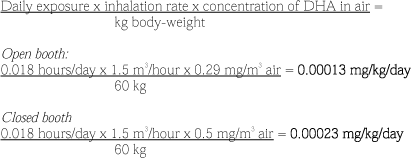
Weekly exposure, all year:
| Weight of subject: | 60 kg |
| Inhalation rate: | 1.5 m³/hour |
| Number of treatments: | 0.14/day |
| Exposure time per treatment (15/60=) | 0.25 hours |
| Daily exposure time (0.14 x 0.25 =) | 0.035 hours |
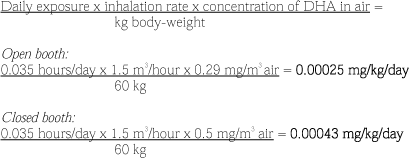
In addition to this is exposure during the treatment itself. The total exposure has been calculated in section 6.1.3.
6.1.1.5 Size of particles and deposition
When using spray booths a spray mist is formed composed of small droplets of lotion (aerosols). The physical and chemical properties of aerosols determine where they are deposited in the airways and the possibilities for the lungs to clear themselves (clearance).
Large aerosols/particles are relatively independent of the surrounding movement in the air, whereas small aerosols follow the movements in the air. Large aerosols (30 µm - 60 µm) are filtered out via nasal hair. Aerosols/particles which get through the nose/mouth are called inspirable or the inhalable fraction (< 25 µm). Many of these will be deposited in the upper airways and on the larynx. The upper airways go from the larynx up to the surrounding/outer air. This includes the mouth (40).
The fraction of aerosols which is not deposited in the upper airway or the larynx passes the larynx and makes up the lung fraction (thoracic fraction (< 10 µm)), and it comprises the aerosols deposited in the trachea, the large bronchus and the small bronchus. This is called the tracheobronchial part (41).
The aerosols passing here and reaching right down to the respiratory bronchials and alveolar ducts are called the respirable part (<1-5µm). Not all respirable particles are deposited in the alveolar ducts, some are exhaled again. This fraction will primarily be composed of aerosols < 1µm (41).
The distribution of the droplet size was only registered at one measurement. The techniques in the various booths are different and therefore the droplet size also differs. For the preliminary calculations it was assumed that 100 per cent of the measured inhalable aerosols (particle size < 12 µm) were taken up.
Figure 6.2 Result of NERI measurements during treatment in a third-generation booth
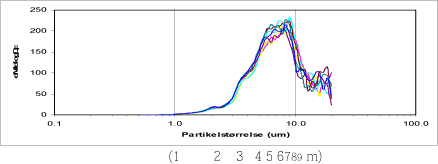
Figure text
Particle size
The vertical axis is the amount and the horizontal the particle size. Note that the axis for particle size is logarithmic. Particles were collected <12 µm. The figure above shows that most particles are in the range 5-10 µm, i.e. a thoracic fraction. The respirable (<1-5 µm) and inhalable fractions (<25 µm) make up the next largest fractions.
The technical description of fourth-generation booths states that the aerosols are 10-times smaller than in the third-generation booths, and this means that the size of the droplets will primarily be <1 µm. Much of this fraction will be exhaled again (41).
6.1.2 Exposure via the eyes and mucus membranes
Customers are instructed to keep their eyes shut during all treatments. This means that the eyes are only exposed when the customer accidentally blinks. In a worst-case scenario the exposed part of the eye is deemed to be the same size as the eye lid. The eye's surface was estimated to comprise one-third of the area on which eye-shadow is applied, i.e. 1/3 x 24 = 8 cm² (42).
Several salons recommend using disposable panties. In a worst-case situation the customer will not use these, and this means exposure to the outer parts of the genitals. The worst case will be a female customer. No measurements were found in the literature. An estimate of the exposed part of the female genitals is 25 cm².
The total area of the exposed mucous membranes and eyes is estimated at (2 x 8 cm² + 25 cm² =) 41 cm².
Mucous-membrane and eye exposure is estimated to be the same for treatment using all three of the techniques described. Compared with the background exposure via the air, it is estimated that the background exposure via the mucous membranes is very limited as the operator or customer are both usually dressed outside the booth. Two worst-case scenarios for customers. 1) a customer who repeats treatment each week during the winter months. 2) special cases such as TV presenters, actors and models, where exposure could be weekly throughout the year. The genitals will be exposed for a long time as it is recommended not to take a bath or shower within 24 hours after treatment. Therefore, it is assumed that absorption of DHA via the eyes and mucous membranes is 100 per cent.
Estimates of the amount of product applied which contains DHA are based on information from SCCNFP (42) for skin lotion (8,000 mg lotion per 15,670 cm² skin surface is used, i.e. 0.5 mg/cm² skin). The stated amount of self-tanning lotion used in the various booths (manual application: 25 ml; closed booth: 60 ml; open booth: 15 ml) only gives consumption and not the exact amount deposited on the body. There will be some waste, although this will probably be least in open booths where the lotion is first charged and where the spray is directed more accurately. The following calculations are therefore based on the SCCNFP estimates. As mentioned above, the exposed area of the mucous membranes and eyes is estimated at 41 cm². The amount applied is about 20.5 mg each time. An employee in the salon sitting outside the booths will only be exposed (2 x 8 cm² = 16 cm²) in the eyes, i.e. 8 mg. It is assumed that three treatments are performed per day, spread over the day. I.e. the employee is exposed to 24 mg per day. The number of exposures will be on average (3 x 227/365 =) 1.8 per day.
The result of the exposures is calculated in the EU (SED or Systemic Exposure Dose) in mg of substance per kg body-weight per time and/or per day on the basis of the following data:
1/ Customers receiving weekly treatment in the winter months:
| Weight of person, adult: | 60 kg |
| Number of daily applications (once/week for 6 months): | 0.07 times/day |
| Estimated amount per application: | 20.5 mg product |
| Highest concentration of DHA self-tanner: | 14 weight-% |
| Absorption via eyes and mucous membranes (worst case): | 100% |
Daily exposure amount, DHA, adult:
![]()
2/ Customer receiving weekly treatment all year:
| Weight of person, adult: | 60 kg |
| Number of daily applications (once/week for 12 months): | 0.14 times/day |
| Estimated amount per application: | 20.5 mg product |
| Highest concentration of DHA self-tanner: | 14 weight-% |
| Absorption via eyes and mucous membranes (worst case): | 100% |
Daily exposure amount, DHA, adult:
![]()
3/ Employee in salon:
| Weight of person, adult: | 60 kg |
| Number of daily applications: | 1.8 times/day |
| Estimated amount per application: | 8 mg product |
| Highest concentration of DHA self-tanner: | 14 weight-% |
| Absorption via eyes (worst case): | 100% |
Daily exposure amount, DHA, adult:
![]()
6.1.3 Total exposure
The following presents the overall results of the exposure calculations.
Table 6.5 Exposure via inhalation using self-tanning booths weekly during the winter months
| Place for collection of particles | Daily exposure time, hours |
DHA in sample mg/m³ air |
Exposure mg/kg/day |
| Manual turbine spray | 0.0035 | 0.8 | 7 x 10-5 |
| Closed booth 1st measurement | 0.0001 | 238 | 59.5 x 10-5 |
| Closed booth 2nd measurement | 0.0001 | 115 | 28.8 x 10-5 |
| Open booth 1st measurement | 0.0001 | 3.3 | 0.8 x 10-5 |
| Open booth 2nd measurement | 0.0001 | 17 | 4.3 x 10-5 |
Table 6.6 Exposure via inhalation using self-tanning booths weekly all year
| Place for collection of particles | Daily exposure time, hours |
DHA in sample mg/m³ air |
Exposure mg/kg/day |
| Manual turbine spray | 0.07 | 0.8 | 14 x 10-5 |
| Closed booth 1st measurement Closed booth 2nd measurement |
0.0003 0.0003 |
238 115 |
0.018 0.0009 |
| Open booth 1st measurement Open booth 2nd measurement |
0.0003 0.0003 |
3.3 17 |
2.5 x 10-5 12.8 x 10-5 |
Table 6.7 Exposure via inhalation per treatment (acute exposure)
| Place for collection of particles | Exposure per treat. hours |
DHA in sample mg/m³ air |
Exposure, mg DHA |
| Manual turbine spray | 0.05 | 0.8 | 0.06 |
| Closed booth 1st measurement 2nd measurement |
0.0017 |
238 115 |
0.61 0.29 |
| Open booth 1st measurement 2nd measurement |
0.002 |
238 115 |
1 x 10-7 3.8 x 10-7 |
Table 6.8 Background exposure via inhalation calculated for customer and operator respectively
| Place for collection of particles | Exp. time/treat. hours |
DHA in sample mg/m³ air |
Exposure mg/kg/day |
| Background (closed booth) Operator |
0.28 | 0.5 | 0.0035 |
| Background (closed booth) customer, winter months | 0.018 | 0.5 | 0.00023 |
| Background (closed booth) customer, all year | 0.035 | 0.5 | 0.00043 |
| Background (open booth + manual) operator | 0.28 | 0.29 | 0.0020 |
| Background (open booth + manual) customer, winter months | 0.018 | 0.29 | 0.00013 |
| Background (open booth + manual) customer, all year | 0.035 | 0.29 | 0.00025 |
Exposure of customers to DHA via the eyes and mucous membranes applied as self-tanning products in spray booths:
1/ Weekly in the winter months 0.003 mg/kg body-weight/day
2/ Weekly all year 0.007 mg/kg body-weight/day
3/ Exposure of employee to DHA via the eyes 0.034 mg/kg body-weight/day
Table 6.9 Total exposure to DHA from direct exposure via respiratory system, mucous membranes and background exposure
| Place for collection of particles | Total exposure to DHA mg/kg/day |
| Customer Manual turbine spray, winter months Manual turbine spray, all year |
0.0033 0.0087 |
| Customer, winter months Closed booth 1st measurement |
0.0048 |
| Closed booth 2nd measurement Customer, all year Closed booth 1st measurement Closed booth 2nd measurement |
0.0035 0.0092 0.0083 |
| Customer, winter months Open booth 1st measurement. |
0.0031 |
| Open booth 2nd measurement Customer, all year Open booth 1st measurement Open booth 2nd measurement |
0.0032 0.0073 0.0074 |
| Operator Closed booth |
0.0375 |
| Operator Open booth: + manual |
0.036 |
Table 6.6 shows that personnel are more exposed than customers to any effects from DHA and self-tanning products by up to a factor of 10, and the various treatment booths make no difference to the exposure of personnel or customers. The scenario with personnel includes three treatments per day for 227 days a year. The average figure for treatment is closer to 1-2 per day for the personnel studied. The above calculations also show that exposure of the eyes and mucous membranes is a greater quantitative load than exposure via inhalation.
Ventilation/extractors and cleaning the booths start immediately after treatment. This was delayed for the NERI measurements. This meant higher air concentrations in the background measurements than for normal operation.
100 per cent absorption has been assumed. This has been assumed as no information was found in the literature.
The operators recommend that customers keep their eyes shut throughout treatment. Customers only rarely open their eyes. Any spray mist which comes into contact with the eyes will possibly be rinsed away by tears and so will not remain on the eyes and be absorbed 100 per cent. The eyes of the operators are exposed to significantly lower concentrations of DHA than the value used in the calculations above.
Operators instruct customers on using nose filters and pursing their lips during treatment in automatic booths so that they avoid inhaling the products. This is harder during manual application as this takes 2-3 minutes. The operator asks the customer to keep her eyes closed, use nose filters, and purse lips when spraying the upper part of the body around the neck and head.
Because of the lack of data such as NOAEL, LOAEL, etc. it is not possible to make further conclusions on the size of exposure.
6.2 Safety assessment of DHA
Because of the possible allergenic effect of DHA, people allergic to the substance should avoid skin contact as there is no lower limit for this health effect.
DHA should not be inhaled, as there is no documentation available on the effects of inhalation.
It is not possible to know for certain whether DHA has any effect on the mucous membranes and eyes, as the only test results are for DHA as an ingredient in a product and not for DHA alone.
Only limited documentation is available on the toxicity of DHA and this mostly builds on poorly documented and out-of-date methods. In laboratory tests, DHA has demonstrated genotoxic potential and mutagenic properties. DHA is also a naturally occurring intermediary in the carbohydrate metabolism of higher plants and animals. There are no results showing that DHA has the same effects on human skin. The health effects from long-term use of DHA in self-tanning products are unknown, and therefore it is uncertain how DHA affects the skin after longer usage.
On the basis of this study and the existing knowledge on the substance there is no reason to assume that the use of self-tanning products in spraying chambers poses a health risk for consumers and professional users. On the basis of the limited knowledge on the health effects of DHA, however, it is recommended that the following precautions be taken until further documentation is available:
- Self-tanning products should not be inhaled or come into contact with mucous membranes.
- People with asthma, sensitive skin and cuts and grazes should consult a doctor before treatment.
- Keep the mouth closed and protect lips with lip salve during treatment.
- Expectant and nursing mothers should not use self-tanning products in spray booths.
- Regular weekly use over a long period is not recommended while knowledge about DHA is so limited.
- Self-tanning products do not adequately protect against the sun's rays and therefore when exposed to the sun it is still important to follow advice and use sun cream.
Furthermore, booths should be equipped with extraction devices so that spray is not spread in the surrounding premises with resulting unnecessary exposure of personnel and customers.
Version 1.0 September 2006, © Danish Environmental Protection Agency